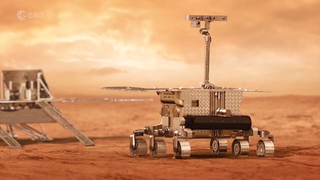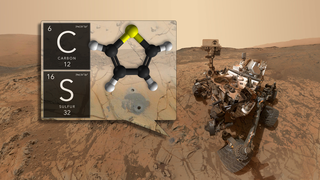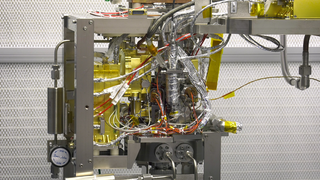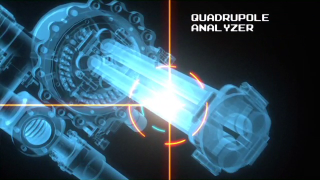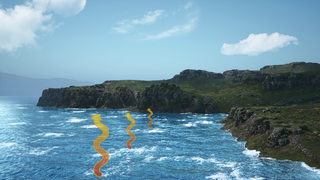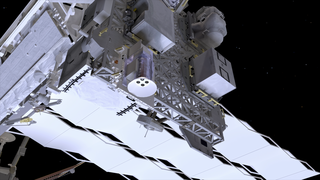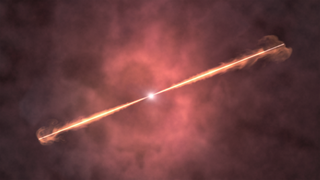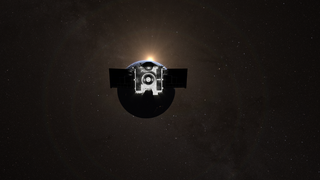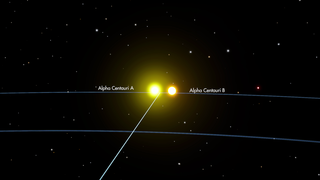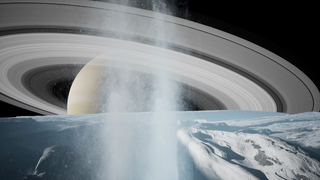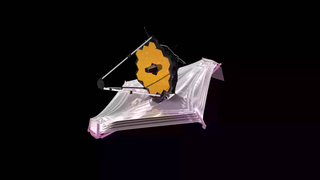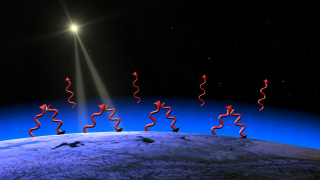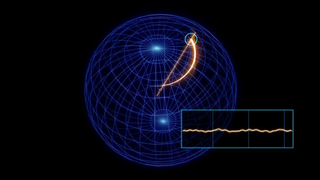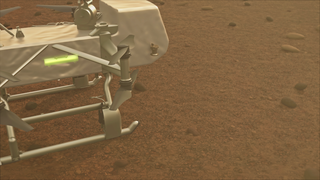Planets and Moons
ID: 20231
One of the biggest questions in planetary science is whether life ever arose on Mars, and NASA and the European Space Agency are sending a cutting-edge instrument to the red planet to find out. The Mars Organic Molecule Analyzer, or MOMA, will be the most sophisticated mass spectrometer ever sent beyond Earth, squeezing a lab full of chemistry equipment into a package the size of a toaster. MOMA will ride to Mars aboard the European Space Agency's Rosalind Franklin rover (formerly ExoMars), and search for signs of past or even present life.
How does MOMA work? Like its predecessor instrument suite on the Curiosity rover (SAM), the MOMA investigation can: vaporize crushed Martian materials in a high-temperature oven; send the evolved volatiles through a gas chromatograph; and ionize and analyze the gases that evolve from the sample via electron ionization mass spectrometry. Unlike previous instruments, however, MOMA offers a complementary second mode of operation, laser desorption mass spectrometry, whereby pulsed ultraviolet light desorbs and ionizes organics in a single step lasting less than two nanoseconds. This mode of operation accesses a new realm of organics detection and preserves weak chemical bonds that are important for molecular identification.
In order to separate and detect different organic compounds within the same sample, MOMA employs a linear ion trap (LIT). The high-pressure operation of the LIT also enables laser processing at Mars ambient pressures. MOMA marks the first use of a linear ion trap in space, and the first ion trap (linear or 3D type) on another planet.
By drawing on a suite of advanced technologies, MOMA will hunt for direct evidence of past or present life on Mars, taking a giant leap forward in the search for life beyond Earth. The mass spectrometer subsystem of the MOMA instrument and the main electronics were built at NASA's Goddard Space Flight Center in Greenbelt, Maryland for the ExoMars Programme. The pulsed UV laser and high-temperature ovens are being developed in Germany, and the gas chromatograph in France. ExoMars is the primary Mars exploration program of the European Space Agency.
Learn more about MOMA and the Rosalind Franklin rover, or watch the narrated video.
The animations on this page are available for download in broadcast resolution and in their original frames.
Mars Organic Molecule Analyzer: Animations
How does MOMA work? Like its predecessor instrument suite on the Curiosity rover (SAM), the MOMA investigation can: vaporize crushed Martian materials in a high-temperature oven; send the evolved volatiles through a gas chromatograph; and ionize and analyze the gases that evolve from the sample via electron ionization mass spectrometry. Unlike previous instruments, however, MOMA offers a complementary second mode of operation, laser desorption mass spectrometry, whereby pulsed ultraviolet light desorbs and ionizes organics in a single step lasting less than two nanoseconds. This mode of operation accesses a new realm of organics detection and preserves weak chemical bonds that are important for molecular identification.
In order to separate and detect different organic compounds within the same sample, MOMA employs a linear ion trap (LIT). The high-pressure operation of the LIT also enables laser processing at Mars ambient pressures. MOMA marks the first use of a linear ion trap in space, and the first ion trap (linear or 3D type) on another planet.
By drawing on a suite of advanced technologies, MOMA will hunt for direct evidence of past or present life on Mars, taking a giant leap forward in the search for life beyond Earth. The mass spectrometer subsystem of the MOMA instrument and the main electronics were built at NASA's Goddard Space Flight Center in Greenbelt, Maryland for the ExoMars Programme. The pulsed UV laser and high-temperature ovens are being developed in Germany, and the gas chromatograph in France. ExoMars is the primary Mars exploration program of the European Space Agency.
Learn more about MOMA and the Rosalind Franklin rover, or watch the narrated video.
The animations on this page are available for download in broadcast resolution and in their original frames.
Used Elsewhere In
Related
For More Information
Animation Credits
William Brinckerhoff (NASA/GSFC): Lead Scientist
Krystofer Kim (USRA): Animator
Ricardo Arevalo (NASA/GSFC): Scientist
Veronica Pinnick (NASA/GSFC): Scientist
Dan Gallagher (USRA): Producer
Krystofer Kim (USRA): Animator
Ricardo Arevalo (NASA/GSFC): Scientist
Veronica Pinnick (NASA/GSFC): Scientist
Dan Gallagher (USRA): Producer
Please give credit for this item to:
NASA's Goddard Space Flight Center Conceptual Image Lab
NASA's Goddard Space Flight Center Conceptual Image Lab
Short URL to share this page:
https://svs.gsfc.nasa.gov/20231
Mission:
ExoMars Rover
Keywords:
SVS >> HDTV
SVS >> Laser
SVS >> Mars
SVS >> Astrobiology
SVS >> Mass Spectrometry
SVS >> Rover
NASA Science >> Planets and Moons
SVS >> European Space Agency
SVS >> Chemistry
SVS >> Journey to Mars
SVS >> Mass Spectrometer
SVS >> Gas Chromatograph
SVS >> Laser Desorption
SVS >> Pyrolysis
SVS >> Ion Trap
SVS >> Linear Ion Trap
SVS >> Desorption
SVS >> Organic
SVS >> Molecule
SVS >> Analyzer
SVS >> Biosignature
SVS >> Alien
SVS >> Extraterrestrial
SVS >> MOMA
https://svs.gsfc.nasa.gov/20231
Mission:
ExoMars Rover
Keywords:
SVS >> HDTV
SVS >> Laser
SVS >> Mars
SVS >> Astrobiology
SVS >> Mass Spectrometry
SVS >> Rover
NASA Science >> Planets and Moons
SVS >> European Space Agency
SVS >> Chemistry
SVS >> Journey to Mars
SVS >> Mass Spectrometer
SVS >> Gas Chromatograph
SVS >> Laser Desorption
SVS >> Pyrolysis
SVS >> Ion Trap
SVS >> Linear Ion Trap
SVS >> Desorption
SVS >> Organic
SVS >> Molecule
SVS >> Analyzer
SVS >> Biosignature
SVS >> Alien
SVS >> Extraterrestrial
SVS >> MOMA
